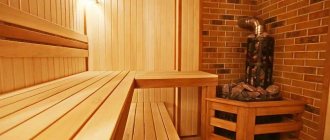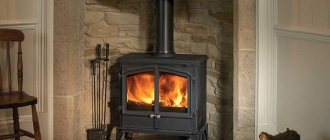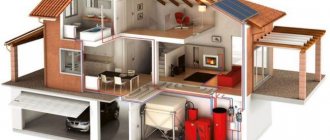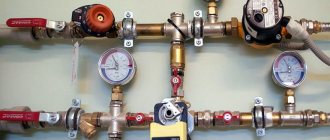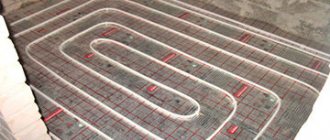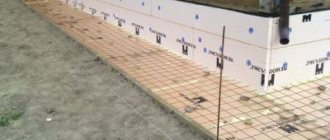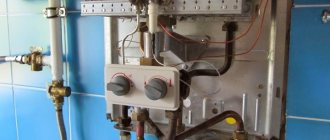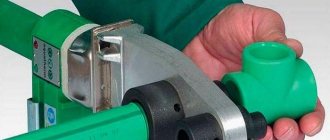- Foundation - standard size of the structure
- With analysis of floors
- Mounting tank assembly
- Advantages of the prototype with a remote channel
- Installation
Steam room stoves are very popular among many homeowners. The market offers a large list of various modifications with different characteristics and sizes. But before installing a metal stove in a bathhouse, you need to know all the fire safety provisions in order to prevent a fire. Let's consider the main points of choosing and installing a heating unit with all the requirements and nuances.
Varieties
The model should not only warm the room, but also not pose a danger to people who will visit the bathhouse. There are several design options that differ in the location of the heating chamber door:
- The firebox opens directly in the steam room - this is the most common scheme. You can not only regulate the burning of wood, but also admire the flame if the prototype is equipped with fire-resistant glass. There are also negative characteristics - dirt, debris, and wood debris accumulate on the floor.
- Installing a stove in a bathhouse with a firebox in the dressing room is the safest option: it saves space, eliminates litter in the washroom, and allows you to warm up all rooms at once.
- The firebox is vented outside - an excellent solution for buildings with a minimum area, but not entirely comfortable - to maintain the desired temperature you will have to run out of the room and systematically add firewood.
There are several design options for devices:
- horizontal;
- vertical;
- oval;
- square.
Modern models have a water tank and a compartment for stones.
A few words about the disadvantages of an external firebox in the dressing room
The most important “disadvantage” of such an engineering solution has already been mentioned - the difficulty of implementing the project for a beginner in the furnace business.
If this is your first oven, then it is better not to risk it and invite a professional to help. But this, as we know, will entail certain financial costs. In addition, there is a possibility that you will have to occasionally interrupt the water treatment to adjust the burning intensity and thus adjust the heat level. And since the firebox is located in the dressing room, you will need to leave the steam room itself into a cooler room. However, we recommend treating this as another veiled “plus”. After all, temperature changes are nothing more than hardening procedures for the body. This means you will get double the health benefits.
Installing a stove in a bathhouse - step-by-step instructions
To save energy and time, you should divide the work into phases. Installation is carried out in five main stages:
- choice of location;
- pouring the base or laying the podium;
- heater device;
- chimney outlet;
- securing a screen that will protect from temperature.
Let's consider each point in detail.
How to choose the right location for assembly
Traditionally, steam rooms are a wooden structure with appropriate finishing. Before you begin installing an iron stove in a wooden bathhouse, it is important to choose the right zone.
Criteria for choosing a fulcrum during construction
You will have to take into account the material of manufacture of the heating device, its power, the design of the combustion chamber and the exit point of the chimney (the usual height is up to 1 meter from the roof to the end point of the chimney). It should be remembered that the heater must be located in a place that is safe for visitors so that no one gets injured. Also key is the proximity of the device to flammable surfaces.
There are rules that must be taken into account during installation.
SNiP requirements for installation
- distance to flammable surfaces – at least 80 cm;
- parameters to the ceiling from the heater - at least 80 cm when it is plastered and 1.2 m if it is made of wood;
- the wooden flooring is protected with a screen, but the height of the firebox is at least 13-15 cm from the floor;
- from the door to the opposite surface – up to 1.25 m.
Stove base
Before correctly installing the stove in the bathhouse, you need to decide which base to mount under the heating device, taking into account the features of a particular model and the type of soil at the construction site. You cannot build shallow foundations if the soil is prone to swelling in winter; it can simply be squeezed out in cold weather.
Foundation - standard size of the structure
Everything will depend on the specific gravity of the heater and the type of soil on which the bathhouse is built. There are several varieties:
- monolithic, deep;
- pile-grillage;
- shallow slab.
Each type has its own positive characteristics and different arrangement methods.
Pouring a monolithic slab base
The algorithm of actions is as follows:
- dig a pit with a height of vertical walls of 50 cm. Compact the bottom, leveling the horizon;
- arrange a cushion of crushed stone and sand, in a layer of 25-30 cm. Sprinkle with water, level and compact well;
- to make a concrete base, for this purpose a liquid solution is mixed. Pour over crushed stone and allow to harden;
- lay a layer of waterproofing - roofing felt glued with bitumen or mastic;
- install formwork from old boards or panels so that the walls are strictly vertical and the angles are 90 degrees. Secure a plastic film on the inside of it so that the plywood does not deform from moisture;
- make reinforcement - the frame should be 10 cm smaller than the formwork on each edge, install a reinforced frame;
- distribution of the solution - you can prepare it yourself or order ready-made. All layers of the mixture are well compacted by piercing them with a sharp iron rod.
After pouring the concrete mixture to the level of the finished floor and allow it to harden for 3 weeks. After this time, the formwork is dismantled and backfilling is carried out - the distance between the base and the walls of the pit is filled.
If you plan to install a brick sauna stove with a firebox from a dressing room, then the installation of the base occurs by deepening it to the freezing line of the soil.
Pile-grillage
This method of arranging the foundation is much simpler and not as labor-intensive compared to the one described above. But it is ideal for unstable, water-logged soil. The execution technology consists of the following stages:
- make markings on the surface, first removing the turf layer;
- in the corners of the future foundation for installing a metal stove in the bathhouse, dig pits 10-15 cm deep;
- screw in piles with a diameter of 10 cm. Be sure to check the vertical;
- cut the posts with a grinder along the bottom line of the subfloor;
- weld a corner channel of the optimal size, arranging a place for pouring the solution;
- place a steel sheet on the beam and secure it with a weld;
- dilute the concrete mixture and pour it into the prepared frame.
Once the concrete has gained the required strength, installation can begin.
Shallow base
This is a simple foundation option for installing an iron stove in a wooden bathhouse.
The algorithm of actions is as follows:
- mark boundaries;
- dig a ditch 50 cm deep;
- fill the pillow with 20-25 cm;
- make a footing;
- arrange waterproofing;
- install formwork;
- pour 30 cm of concrete mixture and compact.
As soon as the concrete sets and dries, you can remove the formwork and lay a layer of insulation - the foundation is ready.
Note: if the base is below the planned level, you can lay 2 rows of brickwork on top of the roofing material. Such a podium will serve as additional thermal protection for the floor covering.
Preparing a Wooden Floor
Installation is not an easy process, especially if the floor is already covered. There are 2 options for solving this problem, let's consider them in detail.
Without disassembling the boards:
- mark lines along the dimensions of the structure directly on the surface. Back off 5 cm and draw an outer quadrangle;
- take a sheet of steel and fit it to the outlined square;
- prepare a layer of mineral wool;
- install a heat insulator on the floor (for example, a mineralite slab or non-flammable drywall), then metal and screw it on;
- soak a brick (preferably fireclay) in water and lay a podium out of it using fireproof mortar strictly horizontally.
Once everything is dry, you can begin further work. The platform can be left open or plastered. After this, you should begin installing a wood-burning sauna stove in a bathhouse with an external firebox on a wooden floor.
On the side of the door you need to screw a steel sheet, part of which will extend onto the brickwork.
With analysis of floors
This is a very labor-intensive process in which the podium for the device and the floor will not be interconnected. If the covering is already laid, it will have to be dismantled or a quadrangle cut to fit the size of the future pedestal.
Masonry is built on the foundation, 2-3 bricks above the floor. Next, actions are taken to isolate from overheating.
Installation of the fuel channel
To install an external combustion channel, a hole is made in the wall. When calculating the parameters of the opening, they rely on its dimensions, which must be taken taking into account the length of the legs of the structure.
To find out the distance between the remote firebox and the surface of the combustible part, take into account the power of the stove:
- This value can be found in the unit manufacturer’s passport. When a structure is built with one’s own hands, fire safety standards are taken into account when calculating the maximum power. Without protection it is 40 centimeters and with thermal insulation -25 centimeters. The dimensions of the opening are not affected by the length of the channel. After installation is completed, the gap between the main part of the structure and the partition must be at least 5 centimeters. The surface of the walls is sheathed with fire-resistant material.
- The finishing of the firebox in the bathhouse, if the channel passes through wooden elements, is done with brick. The masonry should not reach the firebox by about 25 millimeters due to the possible expansion of the metal when heated. A heat-resistant material is placed in the gap; it could be, for example, basalt wool. The heat insulator must be resistant to temperatures up to 1000 degrees.
- If you plan to cover the brick wall through which the firebox passes with wood, you need to step back from the opening by 10 centimeters in all directions. The surface on both sides of the wall is covered with stainless steel sheets, for which holes are made in the metal for an external firebox. An opening measuring 40x60 or 25x50 centimeters is created in a concrete or brick partition.
Walls - preparation
If the load-bearing fence is made of wood, then the distance will be at least 50 cm. For a unit with an external firebox, you will have to cut out a niche.
How to protect partitions from fire:
- apply the plaster composition to a metal mesh previously screwed to the surface;
- install an iron screen with a non-combustible insulator;
- clad with artificial stone or porcelain stoneware;
- make a brick layout;
- adjust factory thermal insulation.
The best option is to lay the masonry on the side of the adjacent surfaces; it will not only protect them from fire, but also accumulate heat.
How to install a heating device
Many home craftsmen ask how to properly install a sauna stove on an already poured foundation.
There is no need to attach the heater to the foundation, but sometimes experts advise attaching the legs to anchor bolts.
If you are installing a model with a protruding channel, then it is important to well insulate the portal from fire - this can be done using polyurethane foam or other material that does not ignite.
Finishing work
It is necessary to check the “operability” of the system - to heat the stove.
Kindling the stove
Check the draft; there should be no odors or smoke in the room. Test the traction on different wood burning modes
Important note: the firewood must be dry. During the burning of wet wood, a lot of moisture condenses on the walls of metal chimneys, to which soot sticks.
The result is that the nominal diameter of the chimney decreases, the draft force is disrupted, and frequent cleaning of the internal surfaces of the pipe is required. To clean the chimney you need to disassemble the pipes. Doing this is long and tedious; there will be plenty of dirt in the bathhouse.
And one last thing. Some bathhouse owners install a damper on the chimney to preserve heat. We do not recommend doing such things. Firstly, a bathhouse is not a room in which you need to keep warm all night. Secondly, premature closing of the damper often causes carbon monoxide poisoning.
Shiber
Setting up a chimney
You need to understand how to build a chimney so that carbon monoxide does not enter the steam room.
The furnace pipeline gets very hot and can cause a fire, so the place is prepared especially carefully:
- make markings in the ceiling and cut a window measuring at least 50x50 cm;
- install a passage unit with mineralite into it with a hole equal to the diameter of the pipe + 3-5 mm;
- secure the polyurethane foam with special fasteners and attach it to the ceiling;
- insert a pipe into the protective box and cover it with kaolin wool to a depth of 5-7 cm, no more, so as not to create the opposite effect of overheating;
- After completing the work, use a stainless steel protective screen to increase fire safety, as well as for decorative purposes.
Advice: no matter how well the installation is done, you need to know how to properly ventilate the bathhouse, otherwise the balance of air exchange will be disrupted.
Below is a link to a video where you can learn more about this system:
Mounting tank assembly
This mandatory element can be attached as follows:
- fixed on the side wall of the stove;
- placed on top of a single-wall chimney;
- at the end, the heat exchanger is connected to the tank for uniform circulation of liquid.
You can study the issue in more detail and visually examine the process in the video:
Useful tips
When heating the stove, the smoke must go freely into the chimney, since if carbon monoxide is not removed through the hood, it can cause serious harm to the human body. If a problem exists, you must immediately find the cause of the weak draft and eliminate it.
Several ways to determine the absence or interruption of furnace draft:
The easiest way is a regular sheet of paper or a lit match, brought to the open door while the stove is firing. If the sheet or flame of a match deviates inward, then there is a draft. If there is no deviation or it occurs outward, then there may be a so-called backdraft, which can be very dangerous.
- One of the reasons for weakening draft may be a depressurized chimney, crack, break, pipe shift, or other defects.
- Another danger is an accidental spark falling into a crack in the chimney onto flammable material, which leads to a fire.
- The small size of the blower through which the exhaust is made can lead not only to the occurrence of reverse draft, but also to an insufficient supply of oxygen to the fuel combustion process.
- Blockages in the chimney can also interfere with the process of normal draft. In this case, regular chimney cleaning will help restore normal air movement. It should be noted that the presence of even one elbow in the pipe, where the bulk of soot accumulates as a result of aerodynamic processes, will greatly complicate the work of the “chimney sweep”.
- If for some reason the stove cannot be heated for a long period of time, an air plug consisting of dense air layers may form in the chimney. As a rule, it resolves immediately after regular heating begins on its own.
- Insufficient firebox volume.
- A wide and long chimney does not work with a small firebox.
How to install a stove in a bathhouse
This process is a little more complicated than installing a conventional heating device - creating a niche in the wall to access another room.
It will be easier to purchase a ready-made design, for example, the Atmosphere sauna stove, made of high-quality cast iron.
Advantages of the prototype with a remote channel
Models with take-away fireboxes are becoming more popular, as they have many more advantages:
- safety - there is no risk of gas poisoning from burning wood;
- comfort – two rooms are heated at once;
- cleanliness - there will be no chips, sawdust or dirt from the firewood. This is very important, since people usually wear it without shoes;
- space saving - as a rule, the oven takes up 1 m2 of space, and if the washing room is small, then this is significant;
- good, saturated steam - the firebox burns out oxygen, which makes the air dry, which has an adverse effect on health;
- there is no need to install a special ventilation system, which saves money and time.
How to determine the required thermal power of a sauna stove?
The power of heating devices is measured in kilowatts. However, manufacturers of sauna stoves take a different approach - they indicate how much steam room volume this model will be guaranteed to be able to heat to a level corresponding to the required microclimate in the steam room. Naturally, subject to high-quality thermal insulation of the latter.
This is usually indicated in passports - for rooms, for example, from 10 to 16 m³.
It would seem that everything is very simple. It is not difficult to determine the volume of the steam room, and it will be just as easy to choose a model. However, the features of the arrangement of the bathhouse can make their own adjustments.
Below is a calculator that will calculate, so to speak, the conditional or reduced “volume” of your steam room, that is, taking into account all the necessary amendments. Based on this value, it will be possible to more accurately select the optimal oven.
For example, if the result is that a stove of 11 m³ is needed, then they try to choose so that this value is approximately in the middle of the range of capabilities of the purchased model. That is, say, a stove designed to heat from 8 to 14 m³.
Calculator for calculating the conditional power of a sauna stove
Go to calculations
A few explanations on the calculation.
- It is clear that first of all the actual volume of the steam room is taken into account. To do this, you need to indicate its linear dimensions: length, width, height.
- Sauna stoves are designed for operation in high-quality insulated rooms. But in practice, it happens that log or timber bathhouses are not insulated from the inside. In this case, a fairly significant part of the heat will be spent on heating the walls, which have considerable heat capacity. Therefore, an amendment is necessary.
- If the stove is located entirely in the steam room, then all the heat generated remains inside this room. But if the firebox is made external (just on the topic of this publication), then part of the thermal energy will involuntarily be wasted on warming up the dressing room and the entire created structure of the “inset” of the stove into the wall. That is, it will also be appropriate to adjust the result.
- The quality of the door leading to the steam room is of great importance. If this is a well-insulated door with a good fit, then significant heat losses through it are not expected. But ordinary panel doors are often installed, as well as glass doors that are becoming fashionable. Of course, their thermal insulation qualities are much lower, and this will also be taken into account when carrying out calculations.
- A window to the street is not a mandatory element of the steam room interior, but it is still often present. That is, another loophole appears for heat leakage. Both the quality of the window and its area matter here. If the window is taken into account, then additional fields for entering this data will appear in the calculator.
- Areas in the steam room (on its walls or floor) lined with ceramic tiles, bricks, and stones can also play a role. Warming up such heat-intensive surfaces will require additional furnace power.
- The result will be shown in standard cubic meters, which should be used as a guide when choosing the optimal sauna stove model.
Safety rules when designing a bathhouse
When organizing a plan for the construction of a steam room, it is important to immediately take into account the placement of the heater, using all recommendations and protective measures that prevent fire.
If the building is made of non-flammable material, then the partitions do not need to be thermally insulated; it is enough to protect the floor with a metal sheet.
If a metal heater is installed in a wooden structure, then carefully insulate the niche without fail - it is better to lay out the brick.
Installing a home-made system requires special attention - the distance from adjacent structures is at least 50 cm, if high-quality insulation from heat is provided, for example, with brickwork. Otherwise, the distance is increased to 1 meter.
It is important to understand that the distance from the firebox door to the opposite plane must be at least one and a half meters.
Installation
The main feature of installing a wood-burning stove for a bathhouse with an external firebox is the presence of a through hole in the wall between the steam room and the dressing room. A capital brick structure will require a lot of labor and expenses for the purchase of material. In addition, it is quite difficult to install such heating yourself - you need to have certain skills. Let's look at the step-by-step preparation instructions developed by experts:
- a niche is cut out, which should be 26 cm larger than the combustion channel;
- the floor is covered with a fireproof slab - this is done in the steam room and in the dressing room in front of the chamber door;
- lay metal sheets on top and screw them with self-tapping screws;
- the firebox is installed flush with the wall or with a small recess (it all depends on the thickness of the partition);
- insulate surfaces adjacent to the heating unit with metal screens;
- After the structure is completely installed, the distance between the heating chamber and the wall must be tightly sealed with any fire-resistant material. The ideal solution would be brickwork - it not only protects well from heat, but also has a beautiful appearance that does not require further processing;
- small gaps between the layout and the walls can be filled with polyurethane foam or basalt fiber.
Once the main work is completed, the metal screens should be decorated in accordance with the overall interior of the room.
Chimney installation
This is the last stage in assembling the structure by a professional; for this you need:
- Prepare the pass-through unit.
- Arrange holes for the pipe; they should be 25 cm wider than the chimney.
- For maximum insulation, take polyurethane foam with mineralite produced by FERRUM and fill it inside to 5-7 cm with kaolin wool, leaving the distance between the pipe and the sheet empty.
- Insert the assembly into the box, having previously protected it with mineralite sheets, fix it to the ceiling from above, and attach the base of the assembly to the lining only after finishing.
- When installing, make sure that the hole coincides with the pipe, because it is strictly forbidden to tilt the system (the maximum permissible error is 1 mm).
- To prevent the pipe from being covered with snow in winter and rain from getting into it in summer, a cap is attached.
Installing a stove in a bathhouse with an external firebox is not difficult; the main thing is to strictly follow the instructions and observe all safety measures, especially for a model made of metal. And if you have no experience in construction at all, then you can watch detailed video instructions.
Design Features
A similar metal sauna stove can be purchased at a retail outlet or online store. Purchased units do not require brick finishing , since they were provided with reliable protection at the factory to prevent burns. This creates certain convenience in using the unit, but still some problems arise with comfort in the room. The reason for this is the rapid cooling of the stove and the need to constantly add firewood. When the fuel burns completely, the steam room becomes very hot; as the fire gradually dies out, the air in the room cools down.
A homemade stove made of metal is quite suitable for use in a bathhouse. The implementation of such a project will require very little time and money. And if such a device is also covered with brick, then it will become safe for use and will evenly release heat.
According to some experts, to implement this idea you will need fireclay bricks. However, it would be more correct to use heavy fireclay, which can withstand high temperatures and, unlike its light counterpart, allows heat to pass through. The peculiarity of lightweight brick is that it is used for the manufacture of melting furnaces that do not require high heat transfer.
At home, this type of material can be used to equip stoves with chimneys. In this case, there is no need to create additional thermal insulation: ordinary red brick will be enough. Its price is significantly lower than the above materials, and to comply with generally accepted standards, the operational and fire safety characteristics of such bricks are absolutely suitable.
Care should be taken when selecting filler for the heater. As a result of heating some stones, carbon monoxide may be released into the steam room. To prevent this, avoid purchasing those cobblestones that have white veins or inclusions.


